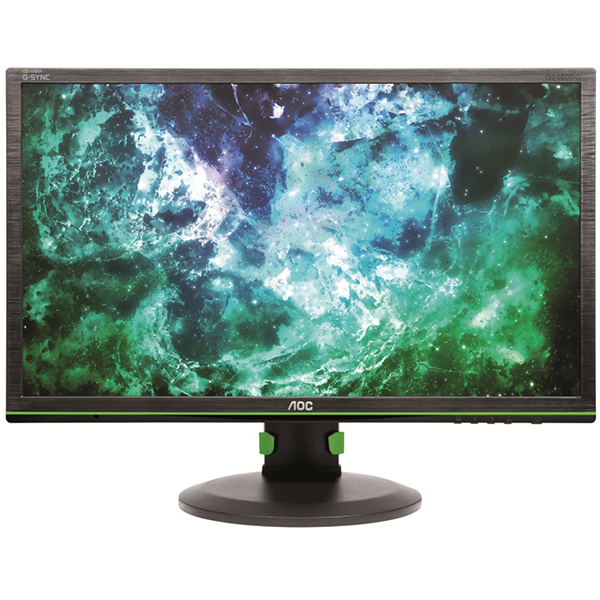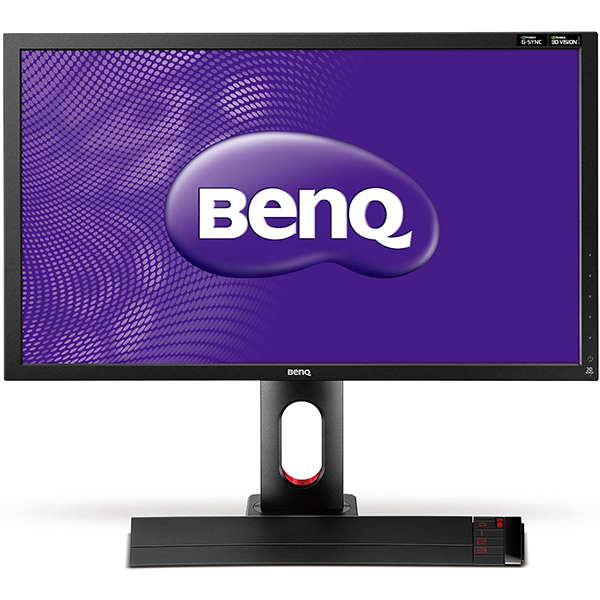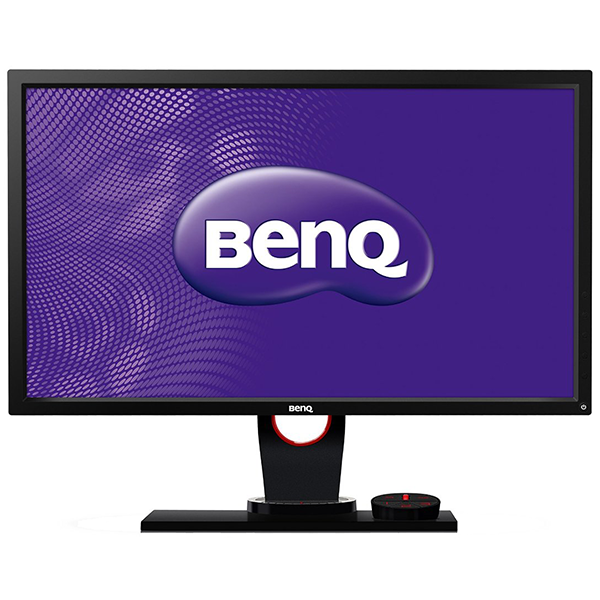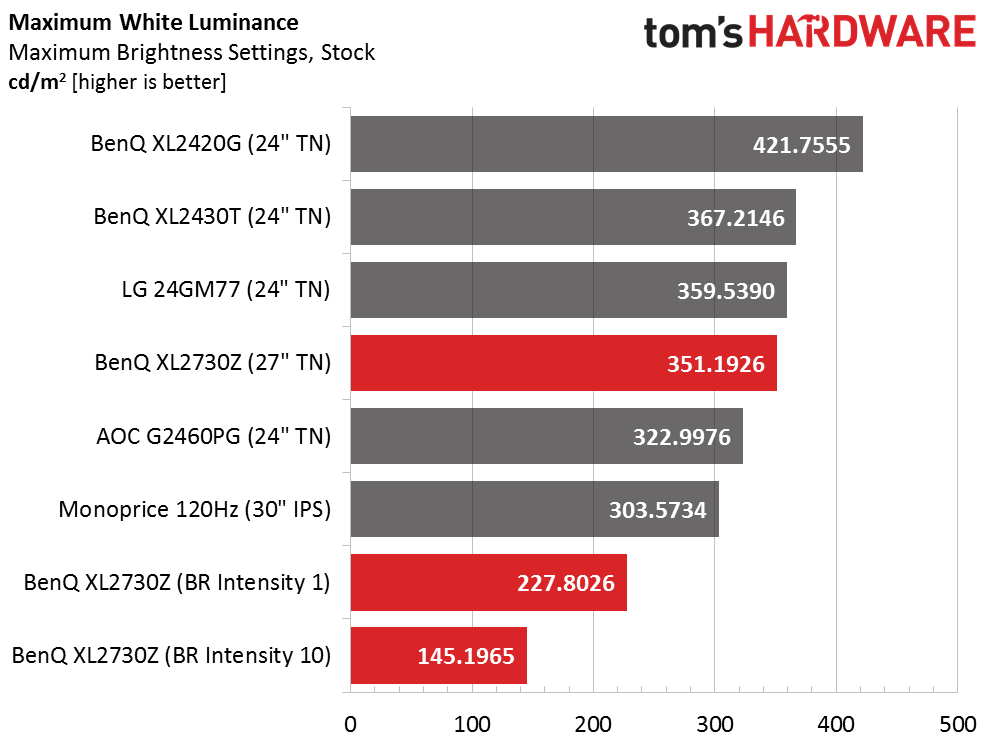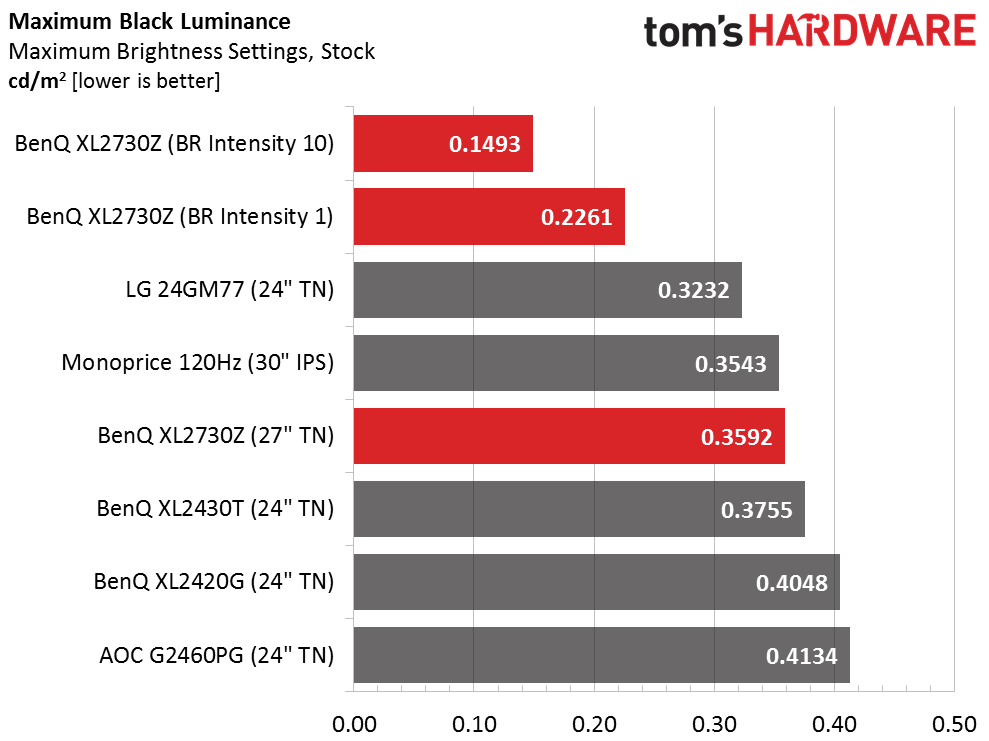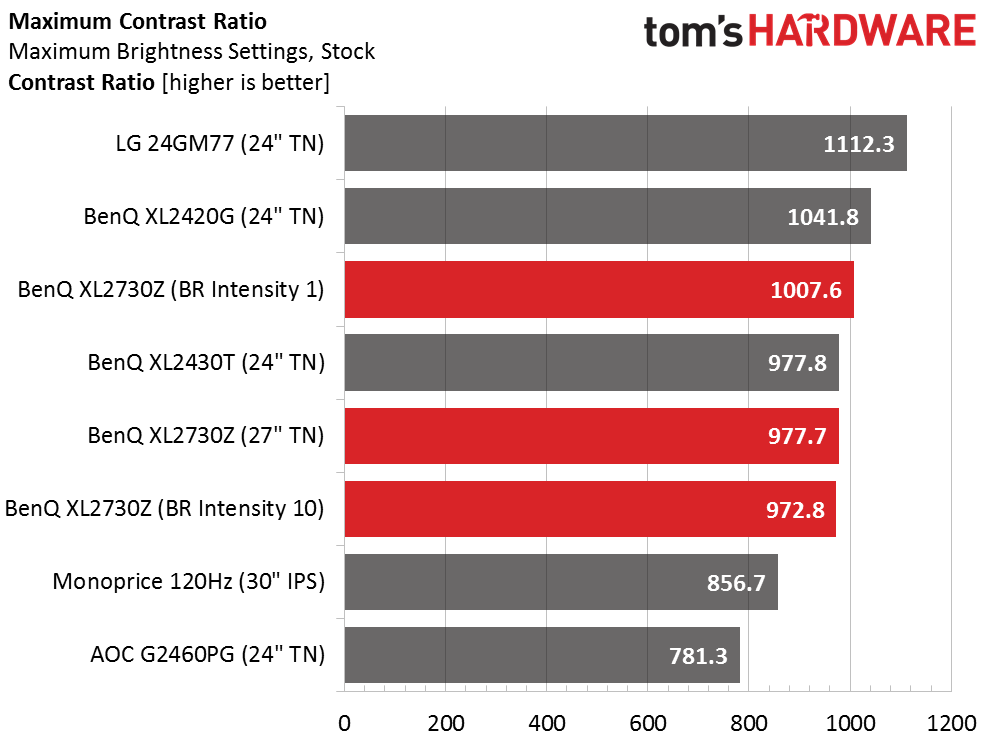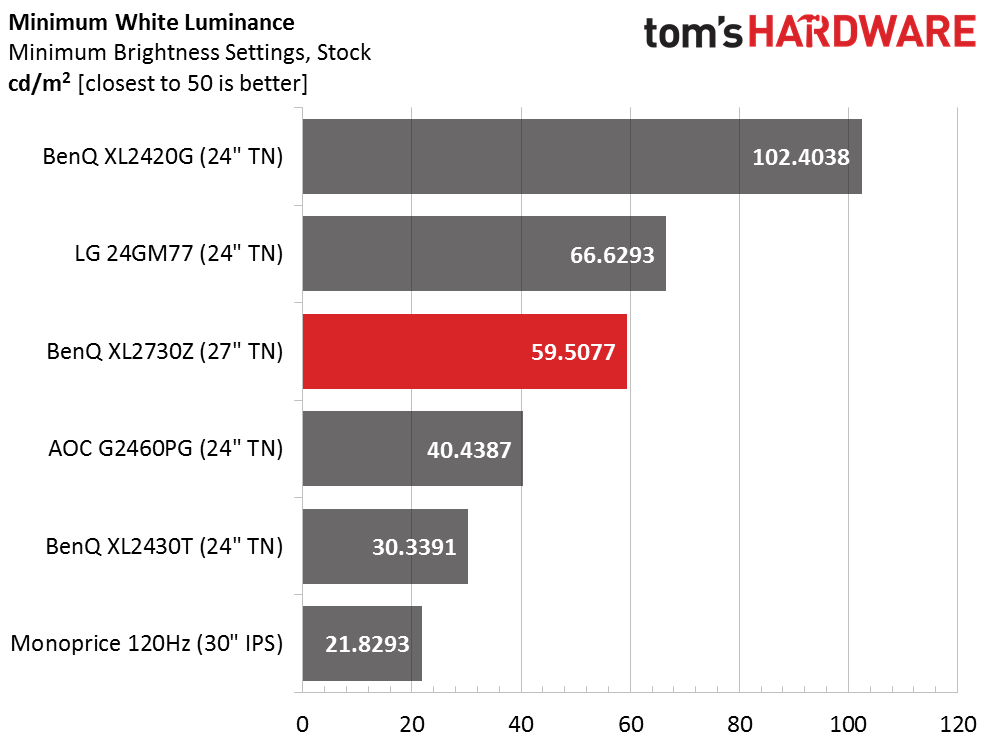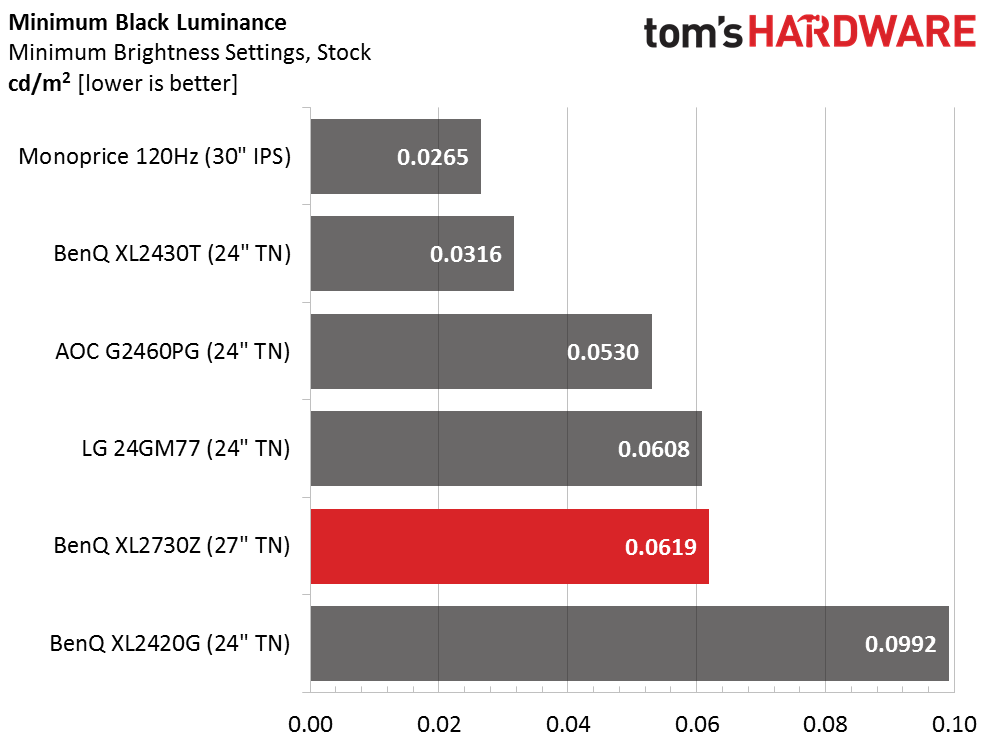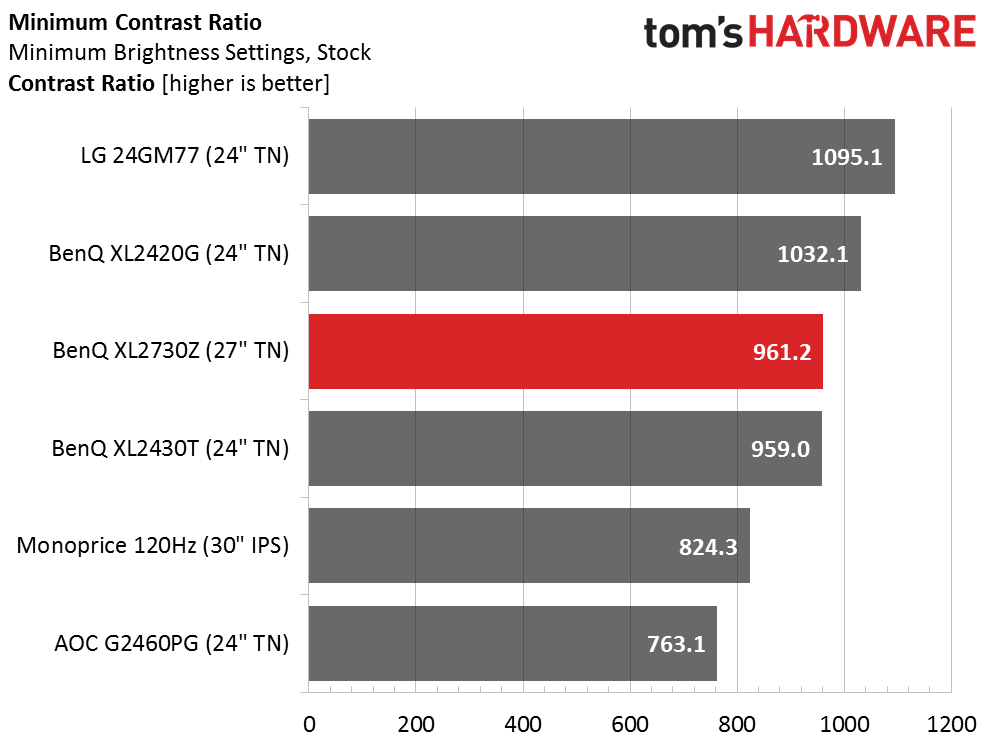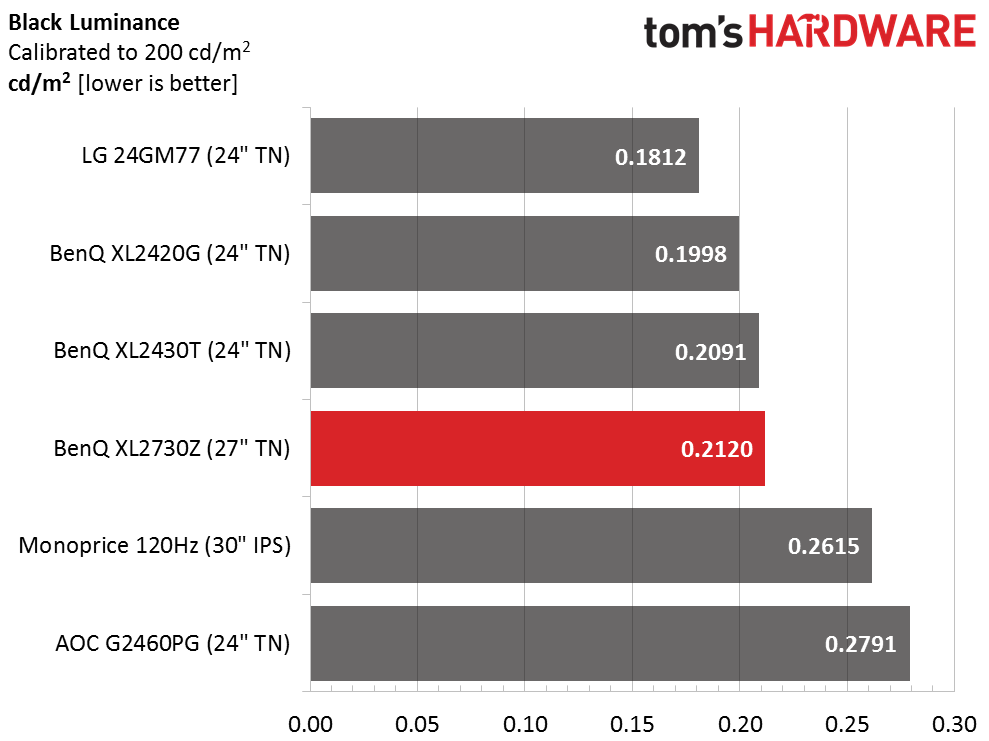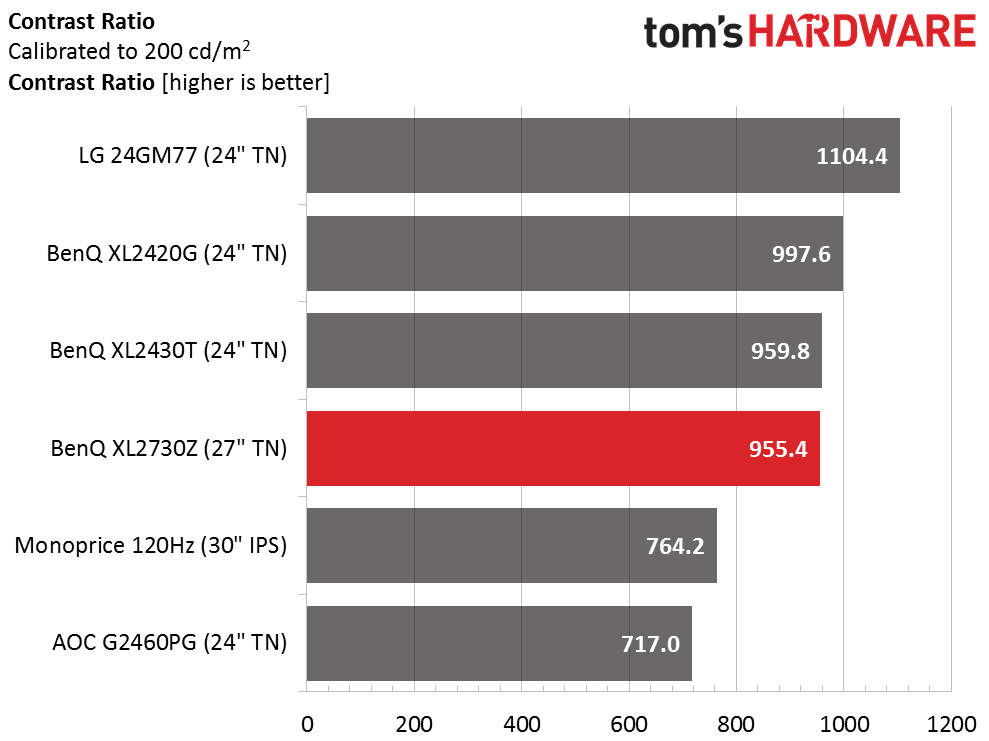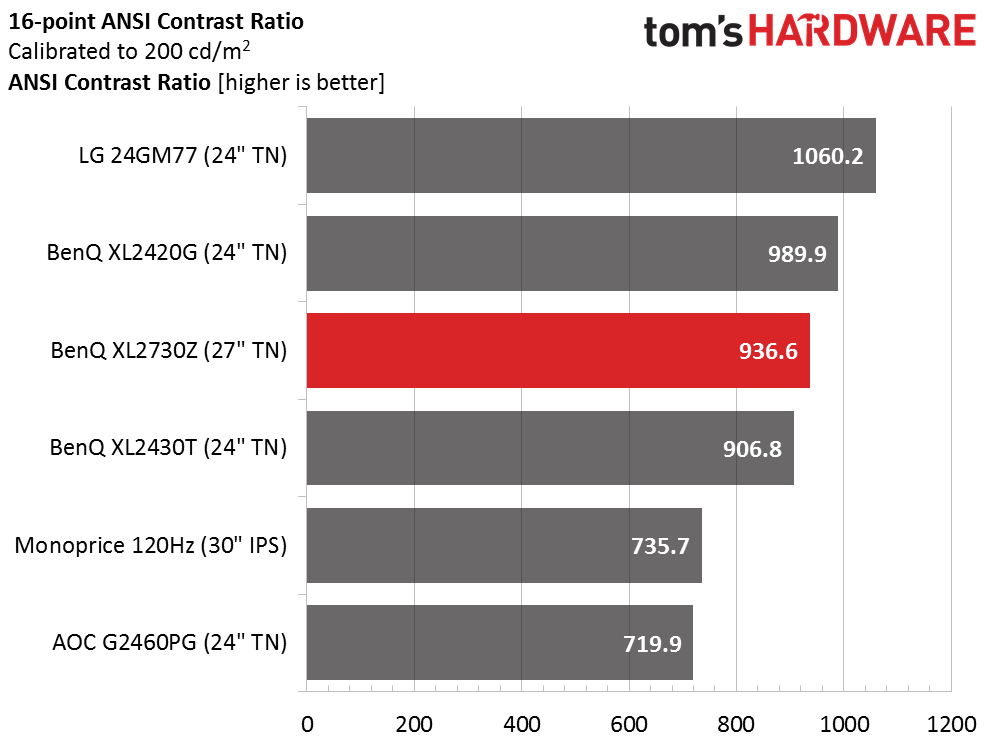BenQ XL2730Z 27-inch FreeSync Monitor Review
For our first chance to examine AMD’s FreeSync, BenQ sent us its brand-new XL2730Z, and we’re running it through our demanding suite.
Why you can trust Tom's Hardware
Brightness And Contrast
To read about our monitor tests in-depth, please check out Display Testing Explained: How We Test Monitors and TVs. Brightness and Contrast testing is covered on page two.
Uncalibrated – Maximum Backlight Level
Today’s comparison group consists of gaming monitors running at 120 or 144Hz. Non-G-Sync screens include the LG 24GM77, BenQ XL2430T and Monoprice G-Pro 120Hz IPS. G-Sync is represented by the BenQ XL2420G and AOC G2460PG.
BenQ rates the XL2730Z at 350cd/m2 and our sample meets that spec. We’d prefer to see more output to better offset the brightness hit from blur-reduction. But in this case, the pulse width slider can be set at its lowest value while still improving image quality noticeably. And the hit to max white level is only 35 percent. If you leave the pulse width at the default setting, the reduction is 58 percent, which is still good. A result of 145.1965cd/m2 is perfectly usable.
Of course, black level drops as you increase the motion blur-reduction setting. At either setting 10 or setting 1, the test result tops the list.
Here’s the best part of all – contrast is slightly higher with motion blur on the lowest pulse width setting. Normally we’d just use it for gaming, but the XL2730Z is the first monitor that let us use motion blur-reduction all the time. And don’t forget, this is one of the few displays that lets you use the feature at its 144Hz refresh rate. Most other screens limit you to 120Hz.
Uncalibrated – Minimum Backlight Level
We turned off blur-reduction for the minimum backlight tests; the image is just too dark otherwise. A 59.5077cd/m2 measurement is great for gaming in a dark room. The 144Hz refresh rate makes the loss of motion blur-reduction bearable.
The minimum black levels almost track the white levels, except for LG's 24GM77, which has higher contrast than the rest. The XL2730Z’s .0619cd/m2 result is perfectly respectable.
Get Tom's Hardware's best news and in-depth reviews, straight to your inbox.
You give up a little contrast by turning off blur-reduction, but at least the ratio stays consistent at all backlight levels. Though it doesn’t quite top 1000:1, it comes close.
After Calibration to 200cd/m2
Calibration costs very little in terms of contrast or black levels. As you’ll see later, it isn’t absolutely necessary. However, there are gains to be had in color quality if you can make the adjustments.
We didn’t have to touch the contrast control or make large changes to the XL2720Z’s RGB sliders. Hence, calibrated contrast is only a bit lower than the unadjusted figure. LG is certainly the king, though, with an excellent 1104.4:1 result.
ANSI Contrast Ratio
ANSI contrast stays solid at only two percent below the calibrated result. We wish this monitor had an IPS panel, but at least the TN part chosen by BenQ is well-built. Still, if contrast is the most important factor in your purchase decision, the LG 24GM77 is a better choice.
Current page: Brightness And Contrast
Prev Page FreeSync & OSD Setup And Calibration Next Page Grayscale Tracking And Gamma Response
Christian Eberle is a Contributing Editor for Tom's Hardware US. He's a veteran reviewer of A/V equipment, specializing in monitors. Christian began his obsession with tech when he built his first PC in 1991, a 286 running DOS 3.0 at a blazing 12MHz. In 2006, he undertook training from the Imaging Science Foundation in video calibration and testing and thus started a passion for precise imaging that persists to this day. He is also a professional musician with a degree from the New England Conservatory as a classical bassoonist which he used to good effect as a performer with the West Point Army Band from 1987 to 2013. He enjoys watching movies and listening to high-end audio in his custom-built home theater and can be seen riding trails near his home on a race-ready ICE VTX recumbent trike. Christian enjoys the endless summer in Florida where he lives with his wife and Chihuahua and plays with orchestras around the state.
-
norseman4 I don't understand why the price is so high. The only things I see that are different (in any meaningful way) from the Acer XG270HU (which I have, and am a fan of) is hight adjustment and an external puck to load configurable screen settings. (that is pretty cool though)Reply
The Acer also doesn't have the raised bezel that is actually about 8mm (Top, Left and Right)
The Benq looks like a good monitor, I just don't see what justifies the premium price. -
Xajel I'll wait for 29" 21:9 1440p instead, the only option available is curved, which is pricey, I don't see the curvation worth the extra cost... FreeSync is a plus but this will drive the cost up again ( to have a 144Hz panel at that resolution )... and please add a USB 3.1 hub with 2x Type-A & 2x Type-C portsReply -
eklipz330 i may have missed it in the article, but what is the range of frames freesync covers on this monitor?Reply -
I Hate Nvidia Replyi may have missed it in the article, but what is the range of frames freesync covers on this monitor?
First thing I was thinking of is FreeSync Range , and I double checked the article and there is no mention of it at all! I think the writer is not well informed regarding FreeSync - GSync Range.
-
JTWrenn This was a good article for a monitor review....it was a very bad article for one of the first Freesync monitors to be released. Many of us wanted more info on that and you acted like all monitors are the same as long as the tech works...that is just not true. Please add more about the Freesync tech, how it worked and what it's limitations were.Reply -
singemagique Why does the author not add a comparison to the Acer XB270HU? Instead they make reference to the ROG Swift? At ~$740, the XB270HU offers 1440p, 144hz, and Gsync on an IPS panel and is definitely at the top of my list at this price point. Could Toms please add info on the Acer panel to this review?Reply -
Falkentyne Christian, I sent you an email about Version 4 firmware for the previous monitor you reviewed--the XL2720Z.Reply
And "Area" is the same thing as "strobe phase" is on the older Z series.
http://forums.blurbusters.com/viewtopic.php?f=13&t=560 -
Bondfc11 He says it's 40-144, but has that been tested? Or is that just the normal statement? Recall plenty of FS monitors state a range and then the panel won't oblige once it was properly tested.Reply -
Falkentyne That's the refresh rate capability, NOT the blur reduction rate capability. The older Z series can't even single strobe at 50hz without a Vertical Total tweak which tricks the scaler into using 60hz backlight pulse widths (if you try single strobe at 50hz without it, the backlight becomes overdriven with voltage and the current makes the monitor reset from overcurrent protection.Reply
It can "double strobe" at 50hz and 60hz but that's only because the single strobe option is missing from the service menu (it was there in all of the previous benq blur reduction monitors including the 2430T).
